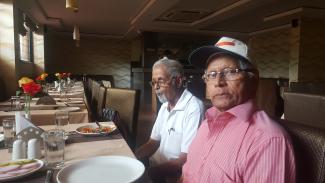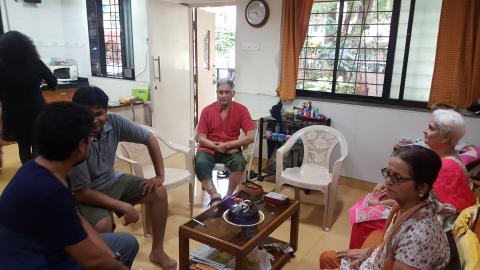
Vasant Samant, a supremely independent man, lost all that was dear to him when he suffered a stroke and was paralysed on the left side of his body. Into 10 years of his stroke, his daughter, Deepa Soman, noted down 10 lessons to caregivers drawn from her experience of inspiring and being inspired.
Carrying his tray of tea and biscuits at 6 am, I enter his room. He has left his door slightly ajar, sign that he is up and ready for his tea. He has pulled the calendar off the wall as is his monthly practice for the page to be turned over. He will deftly do this using left hand and his mouth. Except that today is his birthday and I do it while he is brushing and getting himself ready. I wish him. He beams and says ‘masta’ or ‘great’. It is the one word that he repeats with beaming gusto! The vocabulary is growing but this word is dear to all of us.
A supremely independent man who has lived life entirely on his own terms, our father, Vasant Samant lost all that was dear to him by one stroke of bad luck. Losing his speech and becoming hemiplegic, paralysed on the left side of the body. It was on the early morning of the June 3, 2006, months after his 70th birthday that we found him fallen helpless in the living room of his apartment.
A fighter and positive to a fault, he did not however, lose his will to live and has been at life for 10 years. His is a daily struggle made sweet with his cheerful countenance and his indomitable will or ‘jidda’, one of the first words he started to phonate.
His daily practice of writing with his left hand, seated ramrod straight, never resting his back, his walk, his interactions with home staff and caregivers keep him on the road to recovery after his stroke. They all adore his enthusiasm to exercise. When the top-notch neurophysician, Dr. B. K Singhal, met our father during a follow-up consultation, 3 years post stroke, he pronounced, ‘Aamir Khan should make a movie on him’.
We embarked on a well-planned journey from the time he was in Bombay Hospital. Planning his return and re-organizing his life and ours to facilitate long term care.

He has lost many gifts, but not his sense of victory. He lost his wife, Geeta who turned 50 a year before his retirement from the Times of India, when he was all of 57. His game through our growing years that part irritated, embarrassed and secretly delighted my mother was to say comically loud gestures and all, ‘the whole world on one side and Geeta on the other, what will I choose? And we giggling would loudly chorus “Geetaaaa”.
He loved to travel and see the world and went away to sea to haul coal in the ship’s boiler room so he could tour the world. Now he sees the world through slats, since the vision is both eyes is partially impaired. He enjoyed talking, especially public speaking and could hold forth on any topic very lucidly. He lost his speech and with it, his story-telling. His eyes and his expressions are animated. His ear to ear smile and his gift of the gab helped him sell advertising space in the Times of India.
Today on the 10th anniversary of his stroke, here are 10 lessons to caregivers drawn from our experience of inspiring and being inspired.
1. Acknowledge and accept
Accept the situation objectively. Plan and re-orient your life to the ‘new normal’. It is stroke of luck that the patient is alive, vital and keen to recover. Feel grateful that you and your family have been chosen to partner in the patient’s recovery.
2. Believe in the recovery
Keep the faith. Find purpose and meaning in the event. Know and seek lessons to be learned. Finding meaning liberates anger, frustration, sadness, regret and complaints. It channels positive energy into the situation.
3. Respect
Don’t patronize or be supercilious or superior. Recognize that the stroke has affected the brain and functions. Their thought process and behavior may change, but there is an unchangeable core. Give them time and space to ‘reclaim’ this self. Help them find it with artefacts, pictures and stories.
4. Realism
Be realistic and practical. Show them the vision of recovery, allow them daily actions that improve and maintain their condition. Help them visualize what could be worse. A fall, immobility, not having a supportive ecosystem. Encourage them to take up acts of independence but sound them on safety.
5. Love
Unconditional loving compassion, kindness, affection and humor is a non-negotiable.
6. Patience
Recognize that the patient will have their mood swings – anger, frustration, sadness. Give them psychological air. Let them know you understand without judgment. Let the moment, incident, situation pass. Allow them their dark days. We all have them.
7. Engagement
Spend scheduled time. Develop a routine and stick to it. Engage by observing, listening, informing them of your day. Participate in sharing news, events. Read, watch, play with them.
8. Inclusion
Keep them as an integral, participative part of an equation and not on the periphery.

9. Connect and network
Connect with the patient’s friends, relatives, colleagues, caregivers, doctors, therapists. Enlist and co-opt their partnering. Make the recovery a ‘shared goal’. Everyone is working to the same cause of reclaiming ‘wholeness’. Acknowledge and cherish.
Join our Neurological Conditions Community or Caregiver Community
10. Keep the joy
Positivity begets energy to stay invested in the long haul of the road to recovery. Celebrate wins, big and small milestones.
It is a stroke of luck that the patient and you are on the long journey together. Make every moment count.






